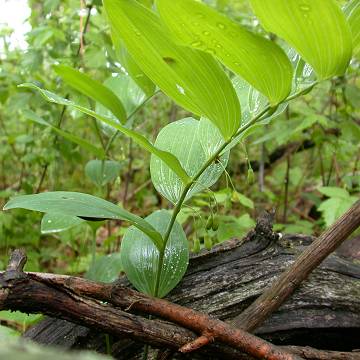

Polygonatum canaliculatum - (image 1 of 7)
Taxonomy
Family: Liliaceae
This name does not seem to be the currently accepted one, with some authorities seeming to prefer P. biflorum (Walter) Elliott. Gleason and Cronquist indicate that this name has been misapplied to tetraploids of this species and use the name P. commutatum for these larger, coarser plants. However, Swink and Wilhelm seem confident that typical P. biflorum does not occur in the Chicago region, with previous floras misapplying P. biflorum to P. pubescens (see below). Are the plants from the Chicago region all tetraploid? If someone knows the appropriate name for plants from the Chicago area, feel free to drop me an email.
Habitat
Moist woodlands. Along roadsides where seeds are deposited by birds. Also found in the shade of open-grown trees, in thickets and along woodland borders.
Associates
Distribution
MA and southern NH west to MN, Manitoba and ND, south FL to northern Mexico.
Morphology
Herbaceous perennial from a jointed rhizome. Leaves to 6" long, sessile, lanceolate to ovate, entire, light green, glabrous on upper and lower surface, parallel veined. Flowers greenish-yellow to white, bell-shaped, to 2/3" long, several borne on arching peduncles from leaf axils; corolla 6-lobed; stamens 6. Fruit a blue-black berry, often with a waxy bloom.
Notes
Flowers mid May to early July
Wetland indicator: Facultative Upland
The name Solomon's Seal refers to the resemblance of the scar left when the stem is removed from the rhizome to the official seal of King Solomon. The rhizome is edible.
Polygonatum pubescens (Willd.) Pursh - Downy Solomon's Seal - is a similar species with leaves that are puberulent underneath. Images 5, 6, and 7 would be referable to this species. I chose to merge them to save space, primarily because the only change to the text would be the preceding description and the fact that P. pubescens occurs on more mesic sites. This species can be found from Nova Scotia west to Manitoba, south to MD, IN, MN, and to northern GA in mountains. It blooms from mid April to mid June. Wetland Indicator: Upland
References
Gleason, Henry A. and A. Cronquist. 1991. Manual of Vascular Plants of Northeastern United States and Adjacent Canada. Second Ed.
The New York Botanical Garden. Bronx, NY
Niering, W. A. 1979. The Audubon society field guide to North American
wildflowers: eastern region.
Knopf/Random House, New York.
Peterson, L. A. 1977. A Field Guide to Edible Wild Plants: Eastern and central
North America
Houghton Mifflin Company. New York, NY
Swink, F. and G. Wilhelm. 1994. Plants of the Chicago Region.
Indiana Academy of Science. The Morton Arboretum. Lisle, Illinois.
|
Michael Hough © 2005 |